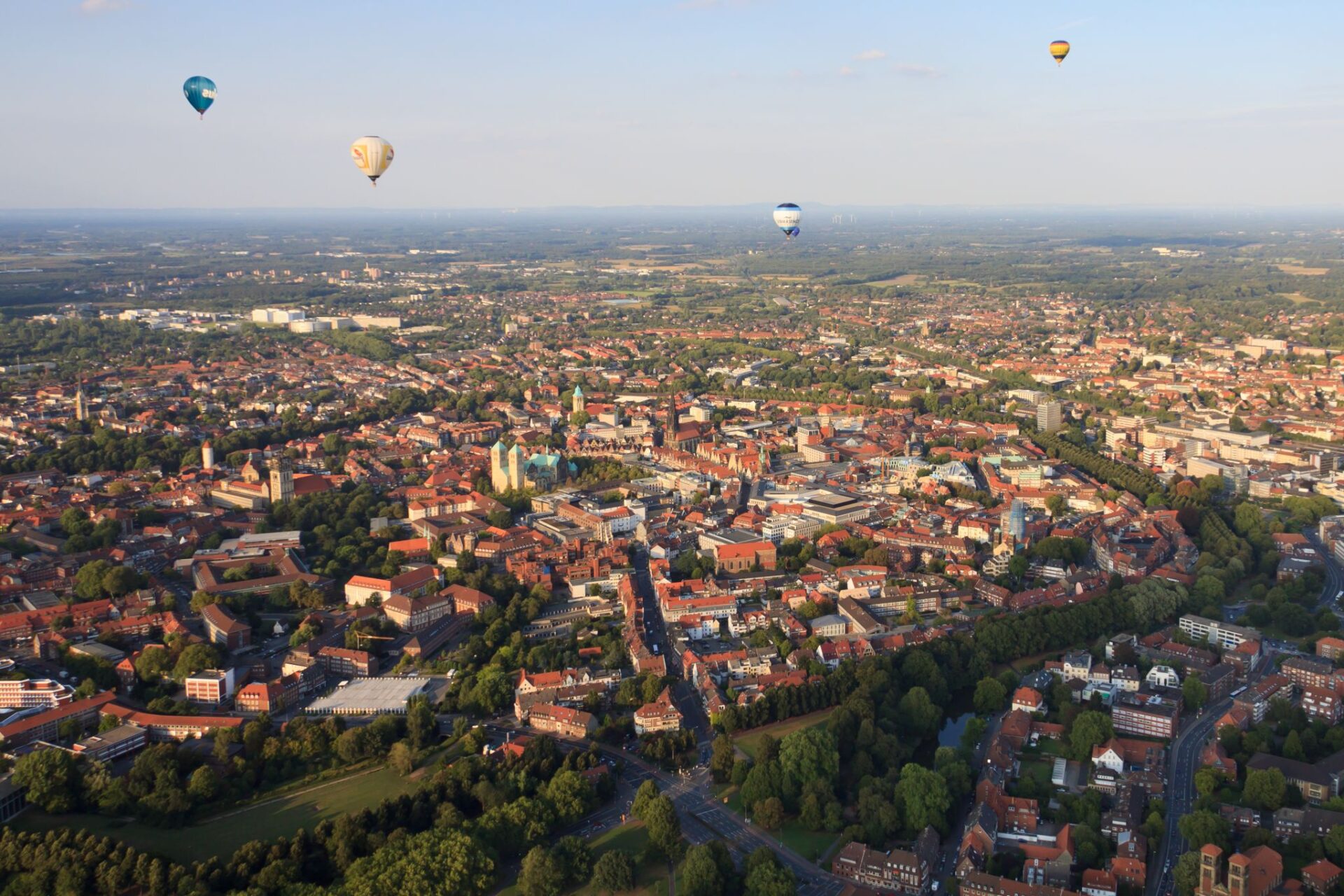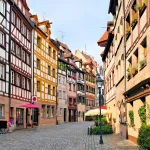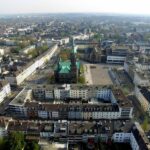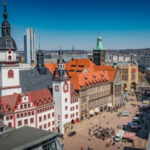A historic university city, Münster is the capital of Westphalia and has a skyline shaped by the Romanesque and Gothic towers of its medieval churches. For hundreds of years up to 1801 the city was ruled by a Catholic Prince-Bishopric. This dominion was only briefly interrupted by an Anabaptist rebellion, which was crushed in brutal fashion by a siege and grisly execution of its leaders who were left to rot in cages over the Prinzipalmarkt square.
1. Münster Cathedral

Image Source: Shutterstock
The city’s emblem is a stirring medieval cathedral from the 12th and 13th centuries. The oldest architecture is the monumental pair of Romanesque towers that forms the westwork from the 1100s. Give yourself plenty of time to investigate the cathedral as there’s a lot to discover.
2. Historical City Hall

Image Source: Walencienne / Shutterstock.com
On the east side of Prinzipalmarkt, the Historical City Hall is another symbol for Münster and one of the finest examples of secular Gothic architecture anywhere. The facade is jaw-dropping, and requires a few minutes for its tiers of traceried windows, ogival arches, gables and pinnacles.
3. Westphalian State Museum of Art and Cultural History

Image Source: rené / flickr
On Domplatz a few paces from the cathedral is the state museum, blessed with art from the Middle Ages to the present. Much of this has religious origins, like the fragment of the Liesborner Altar, which is the pinnacle of Westphalian Late Gothic art and was painted in the last third of the 15th century.
4. Prinzipalmarkt

Image Source: jan kranendonk / Shutterstock.com
The square around the City Hall can tell you all you need to know about Münster’s prestige in Medieval and Renaissance times. On the west side there’s a continuous row of gabled Renaissance houses made from Münster’s characteristic limestone and footed by arcades. Prinzipalmarkt is also one of the city’s favourite shopping destinations.
5. St. Lamberti

Image Source: Shutterstock
A shining example of Late Gothic design, the Church of St. Lamberti was built through the 14th and 15th centuries and forms the northern boundary of the Prinzipalmarkt. All eyes will be on the tower, not least for the hollow tracery on the spire but also for the grim sight of the iron cages above the clock.
6. Picasso Museum

Image Source: commons.wikimedia
This specialised art museum has more than 800 lithographs by Pablo Picasso, making up almost the entirety of his printed oeuvre. The galleries are in two historic buildings, one of which is the Druffel’sche Hof from the 1780s and regarded as Münster’s best example of Neoclassical architecture.
7. Burg Hülshoff

Image Source: Shutterstock
Ten kilometres from Münster’s Altstadt is a picturesque Renaissance castle that was the birthplace of the poet and author Annette von Droste-Hülshoff in 1797. The property is a quintessential Westphalian “Wasserburg” (moated castle), and has been turned into a museum that you’ll visit on a audio guided tour.
8. Aasee

IMage Source: Philip Lange / Shutterstock.com
Hardly ten minutes on foot from Prinzipalmarkt, Aasee is a 40-hectare man-made lake beginning on cusp of the old town and continuing southwest for over two kilometres. There are restaurants and cafes at regular intervals and a raised terrace in the modern complex on the north shore, where you can also hire a pedal boat for self-navigated trip around the lake.
9. Allwetterzoo Münster

Image Source: Günter Hentschel / flickr
The zoo is almost a continuation of Aasee’s green shores and has around 3,000 animals from 300 species. The name comes from its system of covered walkways that offer shelter in all conditions. These are complemented by indoor attractions like BioCity, a conservation centre for turtles, research laboratory and an interactive exhibition on biodiversity.
10. Stadtmuseum Münster

Image Source: wikipedia
On Salzstraße the city’s museum leads you through Münster’s long past from its foundation at the turn of the 9th century to the present. Across 33 “cabinets” you’ll be introduced to the Prince-Bishops who ruled Münster for 700 years and get the inside story of the 16th-century Münster Rebellion and the Peace of Westphalia.
11. Westfälisches Museum für Naturkunde

Image Source: wikipedia
If the weather suddenly goes south, you’ve always got this wonderful science museum as a backup. The exhibitions cover a host of scientific fields, like palaeontology, biology, geology, anthropology, geology, physics and astronomy to name just a handful. There are also special annual exhibitions going deeper on specific topics like whales, the water cycle and bionics.
12. Muhlenhof Freilichtmuseum

Image Source: muehlenhof-muenster
Münsterland’s rural history comes alive at an outdoor museum where some 30 historical buildings from around the region have been relocated and preserved. The museum opened in 1961 when a windmill from Emsland was moved to this site on the west shore of the Aasee, and was soon joined by other village amenities.
13. Botanischer Garten

Image Source: wikipedia
The University of Münster is in charge of the botanical garden, not far west of the Altstadt. The environment is special as the gardens are in what used to be the city’s fortress, and it’s easy to see the star-shaped outline left by the moats. The garden was begun as a teaching and research centre as early as 1803 and its first greenhouses arrived a year later.
14. Cycling

Image Source: Philip Lange / Shutterstock.com
There are half a million bicycles in Münster, which is twice the number of residents! And the city has encouraged people to cycle, setting up three stations for safe parking. The station at the Hauptbahnhof is Germany’s largest, and offers cycle rental as well as a washing and repair service. There are cycle paths throughout the city, so people tend not to worry about protective gear.
15. Wochenmarkt Münster

Image Source: Philip Lange / shutterstock
On Wednesdays and Saturdays the cobblestones of Domplatz are decked with about 150 stalls for a twice-weekly institution that attracts people to Münster from far and wide. Saturday is maybe the livelier day of the two but on either day you can call in for bread, fruit, vegetables, honey, cold-cuts, cheese, pastries, confectionery, seafood, oils and spices. There are also handicrafts for sale like wickerwork, and accessories and clothes.
Places and Things To Do







